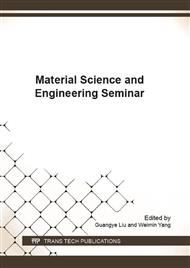[1]
A. Turner, J. S. Walter, Multipolymer systems, Science. 208 (1980) 813-818.
Google Scholar
[2]
H. P. Wang, J. K. Keum, A. Hiltner, E. Baer, Confined crystallization of PEO in nanolayered films impacting structure and oxygen permeability, Macromolecules. 42 (2009) 7055-7066.
DOI: 10.1021/ma901379f
Google Scholar
[3]
R. Y. F. Liu, Y. Jin, A. Hiltner, E. Baer, Probing nanoscale polymer interactions by forced-assembly, Macromol. Rapid Commun. 24(2003) 943-948.
DOI: 10.1002/marc.200300051
Google Scholar
[4]
T. Christopher, S. Sarah, A. R. Jo, F. Bradley, S. Daniel, J. Co-extrusion of multilayer poly(m-xylylene adipimide) nanocomposite films for high oxygen barrier packaging applications, Membrane. Sci. 340 (2009) 45-51.
DOI: 10.1016/j.memsci.2009.05.011
Google Scholar
[5]
Costa, C., Lucera, A., Conte, A., Mastromatteo, M., Speranza, B., Antonacci,A., M. Mastromatteo, Antonacci, A., Effects of passive and active modified atmosphere packaging conditions on ready-to-eat table grape, J. Food. Eng. 102(2011) 115-121.
DOI: 10.1016/j.jfoodeng.2010.08.001
Google Scholar
[6]
C. D. Mueller, S. Nazarenko, T. Ebeling, T. L. Schuman, A. Hiltner, and E. Baer, Novel structures by microlayer coextrusion—talc-filled PP, PC/SAN, and HDPE/LLDPE, Polym. Eng. Sci. 37(1997) 355-362.
DOI: 10.1002/pen.11678
Google Scholar
[7]
D. Chisholm and W. J. Schrenk, U.S. Patent 3, 557, 265, (1971).
Google Scholar
[8]
A. Turner, W. J. Schrenk, and D. S. Chisholm, U.S. Patent 3, 759, 647, (1973).
Google Scholar
[9]
R. Y. F. Liu, T. E. Bernal-Lara, A. Hiltner, E. Baer, Forced assembly of polymer nanolayers thinner than the interphase, Macromolecule, 38 (2005) 10721-10727.
DOI: 10.1021/ma051649x
Google Scholar
[10]
D. Jarus, A. Hiltner, E. Baer, Microlayer coextrusion as a route to innovative blend structures, Polym. Eng. Sc. 41 (2001) 2162-2171.
DOI: 10.1002/pen.10911
Google Scholar
[12]
J. Li, S. Y. Guo, Y. Q. Zhang, Y. Y. Dai, and S. l. Jiang. China Patent 200810147902. 2, (2008).
Google Scholar
[13]
S. Y. Guo, M. Wang, J. Li, J. B. Shen, S. B, Xu, and Q. Du, China Patent 200620036431. 4, (2006).
Google Scholar
[14]
Lee, P. C., Dooley, J., Robacki, J., Jenkins, S., Wrisley, R., Improvements in flex oxygen barrier properties of polymeric films by microlayer coextrusion, J. Plast. Film. Sheet. 30(2013)234-247.
DOI: 10.1177/8756087913506728
Google Scholar
[15]
W. Gao, Y. Zheng, J. B. Shen, S.Y. Guo, Electrical properties of polypropylene-based composites controlled by multilayered distribution of conductive particles, Acs. Appl. Mater. Inter. 7(2014)1541-1549.
DOI: 10.1021/am506773c
Google Scholar
[16]
J. Zhu, J. Shen, S. Guo, H. J. Sue, Confined distribution of conductive particles in polyvinylidene fluoride-based multilayered dielectrics: Toward high permittivity and breakdown strength, Carbon. 84(2015)355-364.
DOI: 10.1016/j.carbon.2014.12.031
Google Scholar
[17]
J. B. Shen, M. Wang, J. Li, S.Y. Guo, Simulation of mechanical properties of multilayered propylene-ethylene copolymer/ethylene 1-octene copolymer composites by equivalent box model and its experimental verification, Eur. Polym. J. 45 (2009).
DOI: 10.1016/j.eurpolymj.2009.07.013
Google Scholar
[18]
A. Rameshwar, S. Volker, L. Katrin, H. M. Goerg, A. Hiltner, E. Baer, Structure and properties of multilayered PET/PC composites, Macromol. Symp, 290(2010) 156-165.
DOI: 10.1002/masy.201050418
Google Scholar
[19]
J. B. Shen, F. C. Michel, Y. Zhi, Y. Qin, G. Richard, S.Y. Guo, The development of a conductive carbon nanotube (CNT) network in CNT/polypropylene composite films during biaxial stretching, Compos. Part. A-Appl. S. 43(2012) 1448-1453.
DOI: 10.1016/j.compositesa.2012.04.003
Google Scholar
[20]
J. B. Shen, F. C. Michel, G. Richard, S.Y. Guo, The development of conductive carbon nanotube network in polypropylene-based composites during simultaneous biaxial stretching, Eur. Polym. J. 48 (2012) 930-939.
DOI: 10.1016/j.eurpolymj.2012.03.005
Google Scholar
[21]
M. Wang, X. J. Sun, L. Su, J. B. Shen, S.Y. Guo, The electrical conductivity of carbon nanotube/carbon black/polypropylene composites prepared through multistage stretching extrusion, Polymer. 53(2012) 1602-1610.
DOI: 10.1016/j.polymer.2012.02.003
Google Scholar
[22]
S. Nazarenko, E. Baer, and A. Hiltner, Oxygen barrier properties of crystallized and talc-filled poly(ethylene terephthalate), J. Mater. Sci. 37, (1999) 847-857.
DOI: 10.1002/(sici)1099-0488(19990415)37:8<847::aid-polb10>3.0.co;2-3
Google Scholar
[23]
M. Matthew, E. S. Donald, F. Lionel, A. W. Mason, S. S. James, E. Baer, A. Hiltner, Reduction of dielectric hysteresis in multilayered films via nanoconfinement, Macromolecules. 45(2012) 1954-(1962).
DOI: 10.1021/ma202267r
Google Scholar
[24]
G. Mohit, Y. J. Li, D. Taneisha, E. Baer, A. Hiltner, and A. S. David, Structure and gas barrier properties of poly (propylene-graft-maleic anhydride)/phosphate glass composites prepared by microlayer coextrusion, Macromolecules. 43(2010).
DOI: 10.1021/ma100391u
Google Scholar
[25]
Y. Bin, C. Xu, D. Zhu, M. Matsuo, Electrical properties of polyethylene and carbon black particle blends prepared by gelation/crystallization from solution, Carbon. 40 (2002) 195-199.
DOI: 10.1016/s0008-6223(01)00173-7
Google Scholar
[26]
Y. Bin, M. Kitanaka, D. Zhu, M. Matsuo, Development of highly oriented polyethylene filled with aligned carbon nanotubes by gelation/crystallization from solutions, Macromolecules. 36 (2003) 6213-6219.
DOI: 10.1021/ma0301956
Google Scholar
[27]
J. G. Simmons, Generalized formula for the electric tunnel effect between similar electrodes separated by a thin insulating film, J. Appl. Phys. 34 (1963) 1793-1803.
DOI: 10.1063/1.1702682
Google Scholar
[28]
E. K. Sichel, J. I. Gittleman, P. Sheng, Transport properties of the composite material carbon-poly(vinyl chloride), Phys. Rev. B. 18 (1978) 5712-5716.
DOI: 10.1103/physrevb.18.5712
Google Scholar
[29]
Podsiadlo, P., Kaushik, A. K., Arruda, E. M., Waas, A. M., Shim, B. S., Xu, J., Nandivada, H., Pumplin, B. G., Lahann, J., Ramamoorthy, A., Kotov, N. A., Ultrastrong and stiff layered polymer nanocomposites, Science. 318 (2007) 80-83.
DOI: 10.1126/science.1143176
Google Scholar
[30]
Russo, G. M., Simon, G. P., Incarnato, L., Correlation between rheological, mechanical, and barrier properties in new copolyamide-based nanocomposite films, Macromolecules. 39(2006) 3855-3864.
DOI: 10.1021/ma052178h
Google Scholar
[31]
Paul, D. R., Robeson, L. M., Polymer nanotechnology: Nanocomposites, Polymer. 49 (2008) 3187-3204.
DOI: 10.1016/j.polymer.2008.04.017
Google Scholar
[32]
Bonderer, L. J., Studart, A. R., Gauckler, L. J., Bioinspired design and assembly of platelet reinforced polymer films, Science. 319 (2008) 1069-1073.
DOI: 10.1126/science.1148726
Google Scholar


